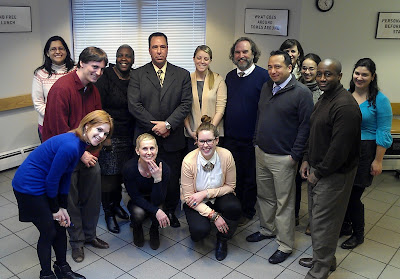Odyssey House Lafayette Avenue client Ashley’s marathon journey was profiled by News 12‘s Jessica Cunnington. Check out the fantastic clip and remember to support the Odyssey House Marathon Team on Sunday, November 1st!
Category: teens
Drug Facts: High School and Youth Trends
As National Drug Facts Week winds down, here’s a look at why the goal to shatter the myths about drugs and drug abuse for teens is so important. The data below is a summary from the latest Monitoring the Future survey, from NIDA’s website.
Illicit Drug Use
Alcohol
Tobacco
Learn More
Let’s Shatter the Myths about Drug Abuse
- Host a local event in your community — don’t forget to register it online
- Distribute the Drugs: Shatter the Myths booklet to teens
- Take the National Drug IQ Challenge, which is updated each year
- Become a social media partner
New program to enhance adolescent treatment in the Bronx
Odyssey House Outpatient Services is introducing a new evidence-based program for adolescent boys (12-17 years) with substance use disorders. Called the Seven Challenges, the program will be incorporated into our existing BUY-In program, which was recently awarded a three-year, $1.3 million contract by the NYS Office of Alcoholism & SubstanceAbuse Services (OASAS).
Odyssey House Grant Focuses on Teens and Their Families
Alcoholism & Drug Abuse Weekly
Last month Odyssey House received a three-year grant from the New York State Office of Alcoholism and Substance Abuse Services (OASAS) for the program’s Bronx Outpatient Clinic. The OASAS grant is funded by the federal Substance Abuse and Mental Health Services Administration (SAMHSA) and is aimed at serving adolescents who have a substance use disorder, as well as their families.
The grant was one of two grants made in the entire state — Odyssey House “downstate” and Citizen Advocates, Inc., based in Franklin County in northern New York, “upstate.” Each grant will expand treatment to 200 additional adolescents over the course of the three-year period.
“The unique needs of young people are often overlooked by mainstream treatment providers,” said OASAS Commissioner Arlene González-Sánchez in announcing the awards. “We need to improve access to treatment for adolescents and the quality of that treatment by expanding the use of nationally recognized evidence-based programs.”
Innovations
Like many of the treatment communities in New York City, Odyssey House has a history of working with special populations. In addition, Odyssey House focuses on innovations, said Peter Provet, Ph.D., president and CEO of Odyssey House. “We had to find innovative ways to work with these populations,” he told ADAW.
Innovations are critical, said Provet, noting that treatment programs need to always be on the lookout for new ways to treat patients. “We cannot just create factories and stamp out the same product,” he said. “There’s always a tendency to do that as an industry matures — to codify, simplify and mass-produce.” Innovations also play a role in obtaining grants such as the OASAS grant, he said.
The Bronx grant is meant to prevent ongoing drug abuse by “targeting kids where they are,” said Provet. Many prevention programs did not take this comprehensive approach in the past, he said. “You would go to a school and give lectures; you had D.A.R.E.,” he said. But the didactic approach isn’t as effective as “engaging kids on various fronts. This grant affords us the ability to go into the kids’ homes, get to know their families, go into their schools, to work with them individually, within family therapy constructs, help them keep journals, and reflect,” he said.
Work with families
The program is based on a successful model from a recently ended SAMHSA grant that Odyssey House kept going after the funding expired, explained Gary Harmon, Ph.D., Odyssey House vice president and the director of research. After an initial assessment in the clinic, counselors will work with teens ages 12 to 17 on the continued engagement with treatment over six months. “The counselors will go into the home, meet with guidance counselors at the school, do journaling, be assessed by the GAIN,” Harmon told ADAW (GAIN is an assessment tool). “We’ll be doing outreach to the schools.” Assessments will be done at six months, with a follow-up six months later.
The grant is in the South Bronx, which is the poorest congressional district in the country, said Harmon.
“When you bring high-quality evidence-based practices to these teens, it really makes an impact,” Harmon said. More than half of the teens in the program are involved in multiple systems, including juvenile justice. By looking at the patient — not just as a patient, but as a client of multiple systems all funded by the state — the impact is multiplied as well, said Provet. “We are at the matrix of criminality, substance abuse, education — all of these issues are impacting our children,” Provet said. “That’s why we’ve gotten these grants.”
The program is “labor-intensive,” said Provet, noting that it takes a lot of time and energy to reach teens and their families. “OASAS was able to get from SAMHSA enough money to support two of these grants,” he said. “I hope there will be a lot more. We have a huge teen drug problem, and we need more than two grants to address it.” •

Odyssey House wins grant to expand adolescent outpatient services
Monitoring the Future survey shows rates stable or down for most drugs
Bringing music and theater to the Leadership Center
| Juilliard dance major Ashley teaches Edward a few moves. |
Residents at the Odyssey House Leadership Center were treated to a special performance by Juilliard students this past weekend. Four students – a dancer, two drama majors and a jazz musician – performed a variety of musical numbers and a scene from Henrik Ibsen play Peer Gynt, and even gave the residents some dance lessons.
Residents bring Thanksgiving to the Rockaways
The project gave the residents the opportunity to be of service to others and learn coping mechanisms for negative feelings or stress. Mr. Kavanaugh said, “Giving back to the community helped them deal with being separated from their loved ones during the holidays. After seeing the devastation in Far Rockaway, residents had newfound gratitude for their current life circumstances.”
Marijuana use on the rise among teens
A new report by the Partnership at Drugfree.org found marijuana use increasing among teenagers. According to the survey, nearly 1 in 10 are smoking pot 20 or more times a month, increasing from 5 percent in 2008 to 9 percent in 2011.
“These findings are deeply disturbing as the increases we’re seeing in heavy, regular marijuana use among high school students can spell real trouble for these teens later on,” said Steve Pasierb, President and CEO of The Partnership at Drugfree.org. “Heavy use of marijuana – particularly beginning in adolescence – brings the risk of serious problems and our data show it is linked to involvement with alcohol and other drugs as well. Kids who begin using drugs or alcohol as teenagers are more likely to struggle with substance use disorders when compared to those who start using after the teenage years.”
To read the Associated Press article about the research findings, click here. The full survey results can be found on Drugfree.org.
Odyssey House operates two gender-specific facilities for young adults with substance use disorders. If you or someone you care about is struggling with substance abuse, contact our Admissions Department at (212) 987-5100.










